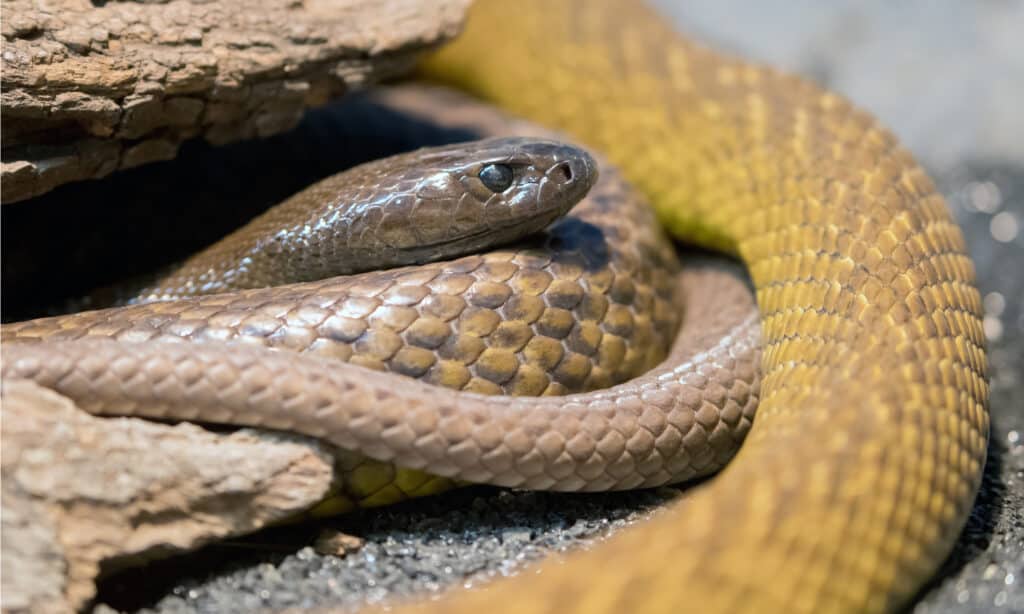The inland taipan is a deadly snake living in Australia that goes by many names. Make no mistake, this creature is just as deadly if you call it the fierce snake or the small-scaled snake. However, it’s not the only venomous creature lurking near Australia. The box jellyfish lives in many warm coastal areas, but the most dangerous and potentially lethal species live off the coast of Southeast Asia and Australia. We’re going to compare the inland taipan vs box jellyfish and show you which of these animals is more deadly than the other.
Comparing an Inland Taipan and a Box Jellyfish

| Inland Taipan | Box Jellyfish | |
|---|---|---|
| Size | – Weight: 3lbs-4.4lbs – Length: 4ft-6ft, up to 9ft maximum | – Weight: 0.5lbs-4.4lbs – Diameter: Up to 8 inches along each side, up to 1ft in diameter. – Other small box jellyfish exist, like Irukandji jellyfish that measure 1cm3 – Length: 9.8ft, but their tentacles count for 9ft or more |
| Venom Potency | – 44mg average venom load with 110mg maximum – Capable of killing between 100 and 280 humans with a single bite – Said to have the deadliest land snake venom – Can cause catastrophic effects in humans in less than an hour | – Total venom on a box jellyfish can kill 60 humans – Causes heart failure, shock, and extreme pain – Venom can kill a human being in times between 2 and 15 minutes. |
| Venom Delivery System | – Uses hollowed fangs to bite creatures and envenomate them | – Several tentacles, up to 15, grow from the box jellyfish’s body – Every tentacle contains thousands of stinging cells called cnidocytes – When the chemical trigger on the cnidocyte is activated, it springs a nematocyst that delivers the venom |
| Envenomation Level | – Nearly 100% envenomation rate and delivers several bites | – Does not always deliver venom because envenomation is not deliberate – The greater part of a tentacle that touches a person, the more venom is injected |
| Aggressiveness | – A skittish snake – Prefers to avoid confrontations with humans, thus interactions are rare. | – Hunts prey, but does not seek out humans – Most contact occurs by accidentally swimming by one or humans going into waters where they live |
| Number of Fatalities Per Year | – No confirmed fatalities due to the remoteness of the snake | – Estimates claim about 100 deaths per year – Antidotes are being developed, and limited treatments are available |
The Key Differences Between an Inland Taipan vs Box Jellyfish

Box jellyfish can kill humans in less than 10 minutes
©Danza/Shutterstock.com
The greatest differences between an inland taipan and a box jellyfish include their morphology, habitats, and venom delivery. Inland taipans are medium-sized snakes that live in remote desert areas in the interior of Australia and deliver venom through bites, and box jellyfish are long marine invertebrates that live off coasts in warm countries and use tentacles to deliver venom.
These animals are very different from each other, but they are both known for their powerful venom. We’re going to examine the unique qualities of these animals and determine which has the deadliest venom of the two.
Inland Taipan vs Box Jellyfish: Size
Box jellyfish are larger than the inland taipan. Box jellyfish vary in size a great deal. The smallest of them hardly weighs half a pound and grows about 1cm3 in overall size. The largest ones weigh 4.4lbs, grow 1ft in diameter, and have tentacles that can reach 9ft in length. The inland taipan is a medium-sized snake that weighs up to 4.4lbs and can grow up to 9ft at its largest.
Inland Taipan vs Box Jellyfish: Venom Potency
The inland taipan has the deadliest venom of any land snake, and the box jellyfish has some of the most powerful venoms of any animal. The inland taipan can kill 280 people with a bite, and the box jellyfish could kill up to 60 people if it used all its venom.
The inland taipan can kill someone in less than an hour, but the box jellyfish can kill someone in just a few minutes. Both venoms cause catastrophic damage to their enemies.
Inland Taipan vs Box Jellyfish: Venom Delivery System

The inland taipan always envenomates when it bites
©reptiles4all/Shutterstock.com
The inland taipan delivers its venom by using its fangs. They engage the muscle around their venom glands while biting to deliver the venom beneath the skin. The box jellyfish has long tentacles with thousands of stinging cells lining them.
When the tentacle contacts prey, a chemical trigger causes the explosive cnidocyte cell to activate, unleashing a venomous nematocyst. This harpoon-like tube springs into the other animal’s skin and delivers venom.
Inland Taipan vs Box Jellyfish: Envenomation Level
The inland taipan is a unique venomous snake because it envenomates its target 100% of the time. Many other venomous snakes use dry bites to ward off foes. Box jellyfish rely on a chemical reaction to occur before envenomating their prey.
Moreover, sometimes the nematocyst does not activate when it’s delivered, so the overall rate of envenomation varies. Nevertheless, the more contact the tentacles make with a human being’s body, the more venom they receive.
Inland Taipan vs Box Jellyfish: Aggressiveness

The inland taipan will slither away from people to avoid a confrontation
©Ken Griffiths/Shutterstock.com
Despite being called the fierce snake, the inland taipan is known for being a rather placid snake. The animal does not go after human beings and bite them. It would much rather get away from the danger. Box jellyfish do hunt their prey, something that is rather unusual for the species, but they do not purposely attack human beings.
The fact that these deadly animals do not purposely attack humans is very beneficial because it results in far fewer deaths.
Inland Taipan vs Box Jellyfish: Number of People Killed Per Year
No records of an inland taipan fatality have been recorded. They live in remote areas and flee from trouble, so they rarely encounter humans. Despite living in the ocean and not purposely attacking humans, box jellyfish kill perhaps 100 people per year.
Inland Taipan vs Box Jellyfish: Which Is More Deadly

The damage caused by a box jellyfish
©DonyaHHI/Shutterstock.com
The box jellyfish is deadlier than the inland taipan. If we look just at the potential venom, the inland taipan wins because it can kill 280 people. However, that’s just one very narrow dimension. We have to think about other issues with the venom.
First off, box jellyfish kill people every year but no records of a human being dying to an inland taipan exist. A human being can accidentally encounter a box jellyfish and die as a result. However, a human would need to go far out of their way to antagonize and trap an inland taipan to make the animal bite them.
We also have to think about how quickly the venom can kill a person. In the case of an inland taipan, a person will begin to have severe symptoms after half an hour. In the worst case, the venom can kill someone in less than an hour. However, effective antivenoms exist that could neutralize the venom and allow the person to live.
Box jellyfish can kill a grown human in just a few minutes. With a large enough dose of venom, a person can go into shock and die before getting out of the water. Some people have made it to shore and died in less than 15 minutes. Box jellyfish antivenom exists but getting it to people in time before they die is difficult. Even when people survive the initial threat to their lives, they live with severe damage.
For all these reasons, box jellyfish are deadlier. These animals kill humans faster and are far more likely to encounter humans in the wild.
The photo featured at the top of this post is © Ken Griffiths/Shutterstock.com
Thank you for reading! Have some feedback for us? Contact the AZ Animals editorial team.







